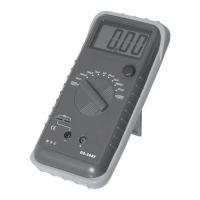10
Manual
6 Preparing:
1. Connect the battery with the device like described in chapter 9.
2. Disconnect all power supply units from the circuits you would like to to measure.
3. Discharge the capacitor before measuring.
4. Connect the device to the capacitor by using the included test leads. Connect the black
test lead to the “-“ socket and the red test lead to the “+“ socket.
5. Never input voltage to sockets, because this could damage the device.
6. Is no function shown at all caused to a low battery, change the battery like described in
chapter 7.
7 Capacity measurement:
1. Adjust the the highest range by turning the rotary switch to 20mF and calibrate the
device by turning the zeroing switch.
2. Make sure the LC display is distinguishable. Avoid direct sun radiation to the display.
3. If the display shows “1“, change the rotary switch to a higher range.
4. If the display shows “0“ or “000“, change the rotary switch to the nex lower range.
5. The semantics are shown as pF, nF, µF and mF.
8 Fuse Check:
The device has a circuit indicator to check car fuses. Insert them to the destinated socket.
The display shows if defective or not.
9 Changing the battery and the fuse:
Change the battery, when the display shows the battery symbol permanently.
Change the fuse, when the device shows no more function at all.
1. Switch off the device and remove all test leads before changing the batery or the fuse.
2. Loose the 3 screws at the back side of the housing with a tting screwdriver.
3. Remove the back side of the housing.
4. Change the battery / fuse to a new one of the same type. (battery: alkaline 9V block,
6F22, fuse: 250V, 0.5A quick acting)
10 Care, Maintenance, Storage and Transport:
ATTENTION! There is a risk of electric shock and short circuit!
• For changing the battery or the fuse, read chapter 8.
• Use a dry linen cloth to clean your product, or use a slightly moist cloth for heavy stains.
Look out for live cables of your device during cleaning! Do not use any cleaning supplies
and avoid liquid entry to the device.
• Avoid the risk of stumbling during installing the mains cable and USB cables.
• Avoid places with high temperatures, humidity, or places which can become wet, also
during care, maintenance, storage, and transport.
• Mind the notes on safety also regarding care, maintenance, storage and transport.
• Reposit the original packaging as protection from dust and humidity for transporting.
• Follow the safety symbols on the packing during transport.

